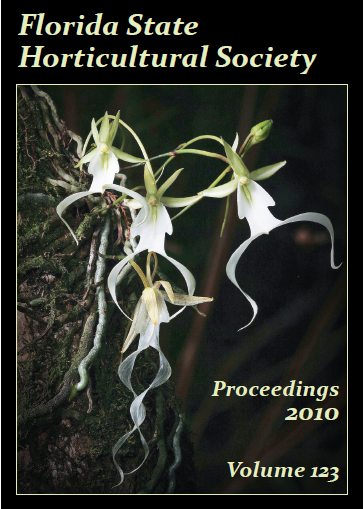Citrus
Ground Application of Foliar Insecticides to ‘Valencia’ Oranges for Control of Diaphorina citri Kuwayama (Hemiptera: Psyllidae)
Publicado 2010-12-01
Palabras clave
- Asian citrus psyllid,
- Citrus sinensis,
- chemical control,
- huanglongbing,
- citrus greening disease
Resumen
The Asian citrus psyllid Diaphorina citri Kuwayama is an economically important insect pest of citrus due primarily to its role as vector of Candidatus Liberibacter asiaticus, a bacterium that causes huanglongbing or citrus greening, a devastating disease of citrus. Insecticidal control is needed to reduce vector populations and slow the spread of huanglongbing. Therefore, foliar sprays of broad spectrum and selective insecticides, both with and without adjuvants, were evaluated against ACP in 14-year-old ‘Valencia’ orange trees during the growing season. Delegate WG, Requiem 25 EC, Micromite 80 WGS, Movento 240 SC, and Portal 0.4 EC applied with FL-435-66 spray oil, Movento 240 SC with Induce and 435 oil applied alone during bloom in March were all effective in reducing psyllid populations for up to two months compared to the untreated control. Orocit was less effective than 435 oil in enhancing the effectiveness of Micromite 80 WGS. The addition of 435 oil enhanced the effectiveness of Actara 25 WG in June and Movento 240 SC + 435 oil was not different from 435 oil alone. Treatments of Actara 25 WG + 435 oil, Agriflex + 435 oil, and Warrior 1SC + Actara 25 WG were all equally effective and reduced psyllid populations for up to 5 weeks. In an August experiment, Delegate WG + 435 oil or Induce and Kocide, Movento 240 SC + 435 oil, Requiem 25 EC + 435 oil or alone, Sil-Matrix and 435 oil alone all reduced psyllid adults for 2 to 3 weeks compared to the untreated control. Requiem 25 EC with 435 oil or alone, 435 oil alone, Sil-Matrix and Delegate WG + Induce were less effective than other treatments against nymphs. Danitol 2.4 EC, Warrior 1SC, Dimethoate 4 EC, Lorsban 4 E, and Imidan 70 W all applied alone in September provided effective psyllid control for up to 5 weeks. Treatment effects on adults were more pronounced and longer lasting than those seen on immatures, in part because of new flush growth. Consequently, the magnitude and duration of psyllid reduction did not compare with that observed applying foliar sprays during the dormant winter period when trees were not producing new growth upon which psyllids depend to mature eggs and for oviposition. Therefore, adults should be monitored regularly and targeted with insecticides at times when trees are not producing new growth.Citas
- Bové, J.M. 2006. Huanglongbing: A destructive, newly-emerging, century-old disease of citrus. J. Plant Pathol. 88:7–37.
- Florida Department of Agriculture and Consumer Services, Division of Plant Industries (FDACS-DPI). 2008. Huanglongbing (HLB)/citrus greening disease. Available from: http://www.doacs.state.fl.us/pi/chrp/greening/citrusgreening.html.
- Halbert, S.E. 1998. Entomology section. Tri-ology (May–June 1998) 37:6–7.
- Halbert, S.E. 2005. Pest alert: Citrus greening/huanglongbing. Florida Dept. of Agr. and Consumer Serv., Dept. of Plant Ind.
- Halbert, S.E. and K.L. Manjunath. 2004. Asian citrus psyllids (Sternorrhyncha: Psyllidae) and greening disease of citrus: A literature review and assessment of risk in Florida. Florida Entomol. 87:330–353.
- Jackson, L.K. 1999. Citrus growing in Florida. Univ. Florida Press, Gainesville. p. 408.
- McCoy, C.W. 1985. Citrus: Current status of biological control in Florida, p. 481–499. In: M.A. Hoy and D.C. Herzog (eds.). Biological control in agricultural IPM systems. Academic, Orlando, FL.
- Qureshi, J.A. and P.A. Stansly. 2007. Integrated approaches for managing the Asian citrus psyllid Diaphorina citri (Homoptera: Psyllidae) in Florida. In: Proc. Fla. State Hort. Soc., 3–4 June 2007. Palm Beach, FL, p. 110–115.
- Qureshi, J.A. and P.A. Stansly. 2008. Rate, placement, and timing of aldicarb applications to control Asian citrus psyllid, Diaphorina citri Kuwayama (Hemiptera: Psyllidae), in oranges. Pest Mgt. Sci. 64:1159–1169.
- Qureshi, J.A. and P.A. Stansly. 2009a. Insecticidal control of Asian citrus psyllid Diaphorina citri (Hemiptera: Psyllidae). Proc. Fla. State Hort. Soc. 122:172–175.
- Qureshi, J.A. and P.A. Stansly. 2009b. Exclusion techniques reveal significant biotic mortality suffered by Asian citrus psyllid Diaphorina citri (Hemiptera: Psyllidae) populations in Florida citrus. Biol. Contr. 50:129–136.
- Qureshi, J.A. and P.A. Stansly. 2010. Dormant season foliar sprays of broad-spectrum insecticides: An effective component of integrated management for Diaphorina citri (Hemiptera: Psyllidae) in citrus orchards. Crop Protection 29:860–866.
- Qureshi, J.A., M.E. Rogers, D.G. Hall, and P.A. Stansly. 2009a. Incidence of invasive Diaphorina citri (Homoptera: Psyllidae) and its introduced parasitoid Tamarixia radiata (Hymenoptera: Eulophidae) in citrus groves of Florida. J. Econ. Entomol. 102:247–256.
- Qureshi, J.A., B. Kostyk, and P.A. Stansly. 2009b. Control of Diaphorina citri (Hemiptera: Psyllidae) with foliar and soil applied insecticides. Proc. Fla. State Hort. Soc. 122:189–193.
- Rogers, M.E. 2008. General pest management considerations. Citrus Ind. 89:12–17.
- Rogers, M.E., P.A. Stansly, and L.L. Stelinski. 2008. Florida citrus pest management guide: Asian citrus psyllid and citrus leafminer. Entomol. Nematol. Dept., Fla. Coop. Ext. Serv., Inst. Food Agr. Sci., Univ. Fla., ENY-734. Available from: <http://edis.ifas.ufl.edu/IN686>.
- Roistacher, C.N. 1996. The economics of living with citrus diseases: huanglongbing (greening) in Thailand. In: J.V. da Graça, P. Moreno, R.K. Yokomi (eds.). Proc. 13th Conf. Intl. Org. Citrus Virolog. (IOCV). University of California Press, Riverside, CA, p. 279–285.
- SAS Institute. 2004. SAS for Windows, Version 9.1. SAS Inst., Cary, NC.
- Stansly, P.A. and J.A. Qureshi. 2008. Controlling Asian citrus psyllid: Sparing biological control. Citrus Ind. 89:20–24.
- Stansly, P.A., H. Arevalo, M. Zekri, and R. Hamel. 2009a. Cooperative dormant sprayprogram against Asian citrus psyllid in SW Florida. Citrus Ind. 90:14–15.
- Stansly. P., J. Qureshi, and A. Arevalo. 2009b. Why, when and how to monitor and manage Asian citrus psyllid. Citrus Ind. 90:24,26,34.

